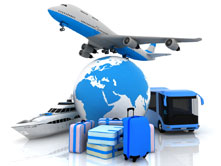All EU members can get into the Italy which is also a member of the Schengen agreement. Citizens of the following countries do not need a visa to enter Italy: Andorra, Antigua and Barbuda, Argentina, Australia, Bahamas, Barbados, Brazil, Brunei, Canada, Chile, Costa Rica, Croatia, El Salvador, Guatemala, Honduras, Israel, Japan, Malaysia, Mauritius, Mexico, Monaco, New Zealand, Nicaragua, Panama, Paraguay, Saint Kitts and Nevis, San Marino, Seychelles, Singapore, South Korea, Republic of China, United States, Uruguay, Vatican City, Venezuela.
1) By Air
There are two main airports in the capital Rome but the largest of them, Fiumicino International Airport, is Italy’s main airport. It is named after the Renaissance painter and inventor Leonardo da Vinci. Milan also has two airports. There are major airports in Genoa, Bologna, Naples, Pisa, Catania, Venice, Bari and Turin, as well as some smaller regional airports throughout the country. The national airline is Alitalia. You can hire a car in Italy from all international airports on arrival.
2) By Land
You can drive or take a train to Italy from almost anywhere in Europe. There are also bus routes to Croatia, Slovenia and Sweden. The bus to Sweden goes via Switzerland, Germany and Denmark.
3) By Sea
It is easy to connect with Eastern Europe by boat from Italy with ferries leaving the ports of Ancona, Bari, Venice and Brindisi to Croatia, Greece, Montenegro and Albania. One of the regular boat services goes from Trieste to Albania. A number of cities also run ferries to Barcelona in Spain and the French island Corsica. A ferry runs from Pozzallo in the south of Sicily to Malta.
|
|
 |